If you’ve ever seen a nest made by bald-faced hornets in your backyard, you know that they can be quite spectacular.
Hornet nests are fascinating structures made from wood fibers (cellulose) that have been chewed by the hornet queen and repurposed into a porous, multilayered, house for hundreds of hornet workers.
The nest is built in the spring and lasts only one season at a time, but the queen singlehandedly builds a new one every spring!
The main purpose of the hornet nest is to house the queen and protect the larvae against cold, rain and predators.
They can be up to the size of a basketball or larger, depending on the size of the colony inside. Of late, they have become quite popular in home décor as well! They certainly make for an impressive conversation piece.
Contents
What do hornet nests look like?
Most nests that you see around your home are made by paper wasps, with the larva cells being totally visible. While they can spread out quite a way, they are usually only a few inches wide.
Hornet nests, however, are much larger and are built in the shape of an upside-down teardrop. They have a protective covering consisting of several layers with one entrance hole.
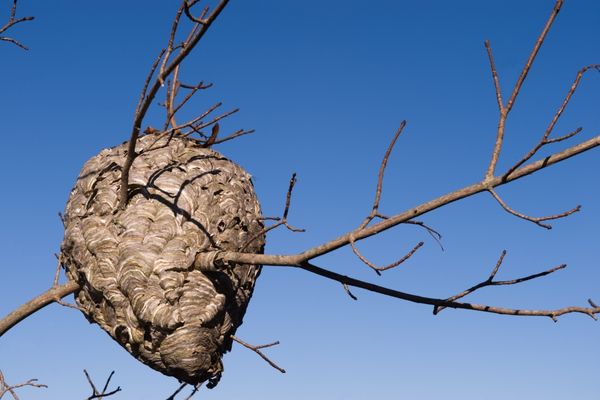
The European hornet likes to nest in holes in trees or sometimes in an abandoned bee hive, so you may not even see their nests.
They still contain the same brood cells and may or may not have the protective covering all around, but they are usually not available to be harvested for decoration.
But whereas the European Hornet is the most common hornet in the USA, there are also the Asian Giant hornet and the ground-dwelling Yellow Jackets.
The Asian giant hornet or yellow jackets will prefer to build their nests underground, and while you cannot directly see the nest then, it has a much more undefined, flat, structure.
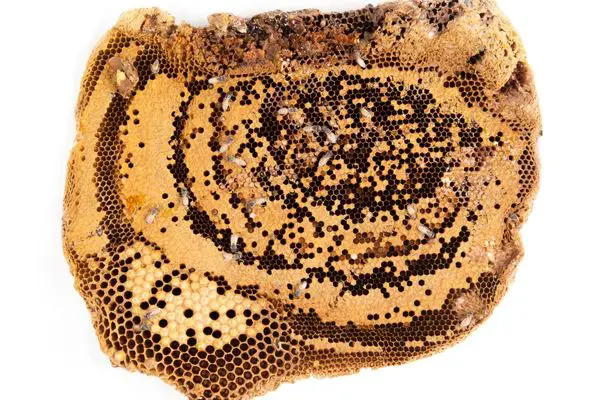
Sometimes they will build a nest inside of a barn or other building, and these nests do resemble those of the bald-faced hornet quite a bit.
Why do hornets build a nest?
Hornets build nests to house their larvae and workers and to protect the queen.
The nests consist of several layers of cells, with the outermost layer being made of tough paper-like material.
The material, like normal wood, is waterproof and will protect the workers, larvae, and queen against heavy rain. And whereas hornets do not mind the rain as much as other insects, they do prefer to stay inside during heavy rainfall.
The inner layers are more porous, allowing air to circulate and keep the temperature inside at a constant level. This is essential for the development of the young.
It also protects the larvae against hungry predators that might otherwise eat them!
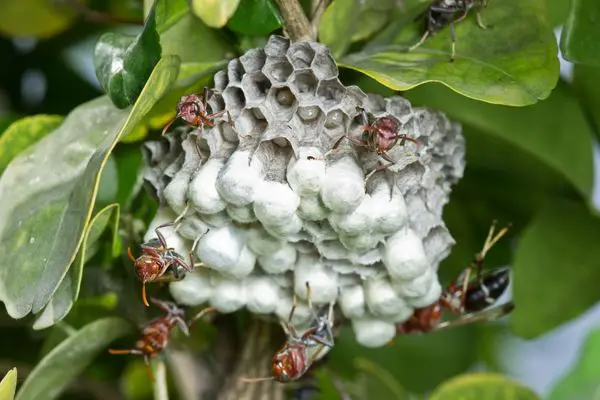
The number of chambers in a hornet’s nest depends on the species, but can be as many as 400 or more.
The cells are wherein the eggs are deposited and where the larvae grow and develop. Once they become pupae, they spin a cocoon within the cell and eventually emerge as adult hornets.
The entire structure is held together by a sticky substance that the hornets secrete. It hardens into a sort of cement, holding everything in place.
How big do hornet nests get?
These can get up to a foot long and just as wide near the top. They certainly are hard to overlook. Bald-faced hornet nests are suspended from a tree branch or the eaves of a building by a single stem, although they can be also attached elsewhere as well.
See some extreme examples in this video:
European hornets prefer to build theirs inside a tree cavity. Sometimes they will nest inside a building or wall cavity and have been known to nest underground as well.
Their nests can be just as large as those of the bald-faced hornet.
Where Do Hornets Build Their Nests?
They usually build nests on tree branches or the branches of large shrubs, at least three feet off the ground.
The easiest way to find them is to follow hornets you’ve spotted in your backyard until one leads you back to the nest.
But hornet nests can be found on almost any vertical surface. They prefer building their nests in trees of woodland areas but have been encouraged by the presence of humans to build their nests in attics, under the eaves of houses, and in any other place that they can access.
However, if they find a good crack in your home’s siding, they have been known to get inside and build nests between the walls.
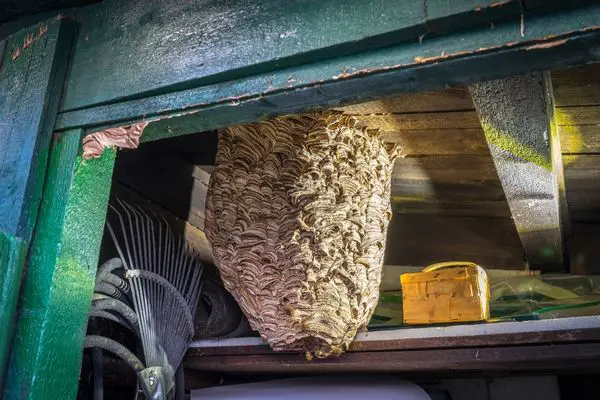
Take care to stay back a good few feet from the nest, as there are always lookouts stationed outside to watch for potential threats. They will attack anything that looks like a threat, and usually in numbers.
If you want to harvest one, wait until your area has had a few hard touches of frost and pick a harvest day with a temperature in the 30s just to be safe.
There won’t be anyone at home in the nest by then with the exception of perhaps a young queen or two. They can be safely released when they emerge.
When do hornets build nests?
The mated queens hibernate in safe, protected places, usually under tree bark, in small rock piles, or even behind shutters. They can also overwinter in cracks in a building or in the eaves.
The queen emerges as the weather warms in spring, then she looks for a suitable place to start a nest.

She’ll build some cells, lay eggs in them, then care for the larvae until they pupate and eventually hatch into sterile female workers. The workers take over the tasks of caring for future young while the queen just concentrates on laying eggs.
How many hornets are usually in a nest?
The average hornet nest holds from 100 to 700 hornets. Naturally, the larger the nest, the more workers it’s likely to house.
Much of the interior space is taken up with larva cells, so it’s not easy to tell how many live there just by the size. Much of the workers’ time is spent outside looking for food.
How long does it take to build a hornet’s nest?
Depending on the species, the location and the weather, it usually takes between two to five weeks for a hornet to fully build its nest.
Whereas the bald-faced hornets typically take longer because they build larger nests, other species of hornets will also build large nests given the right conditions.
For example, if plenty of food is available and the climate is warm and mild, most hornet queens spend more than one month building a large nest because the colony is expected to grow better than in colder less hornet-friendly climates.
Other times, of no good shelter, is to be found and the weather conditions are harsh with strong winds, rain and colder temperatures, the hornets will take around or less than one month to build the initial nest for the colony.
Also, in warmer climates, the nests are not abandoned in the winter, so it makes sense for the hornets to build larger nests and therefore they invest more time and energy into the nests, which is why it takes longer for them to build it.
What is inside a hornet’s nest?
Inside the nest are many layers and the core of the nest contains the larvae and pupae as well as the hornet queen.
There are three main parts to a hornet’s nest: the outer covering, the inner nests, and the cells.
The outer covering is made of multiple layers of chewed wood fibers. It’s very strong and helps to protect the inner nests from the weather and potential predators.
The inner nests are where the hornets actually live. They’re made up of many hexagonal cells that the hornets use for different purposes. Some are used as storage rooms, some are used as brood cells for the larvae, and others are used as latrines.
The cells are where the hornets lay their eggs. They’re also where the larvae develop into pupae before emerging as adult hornets.
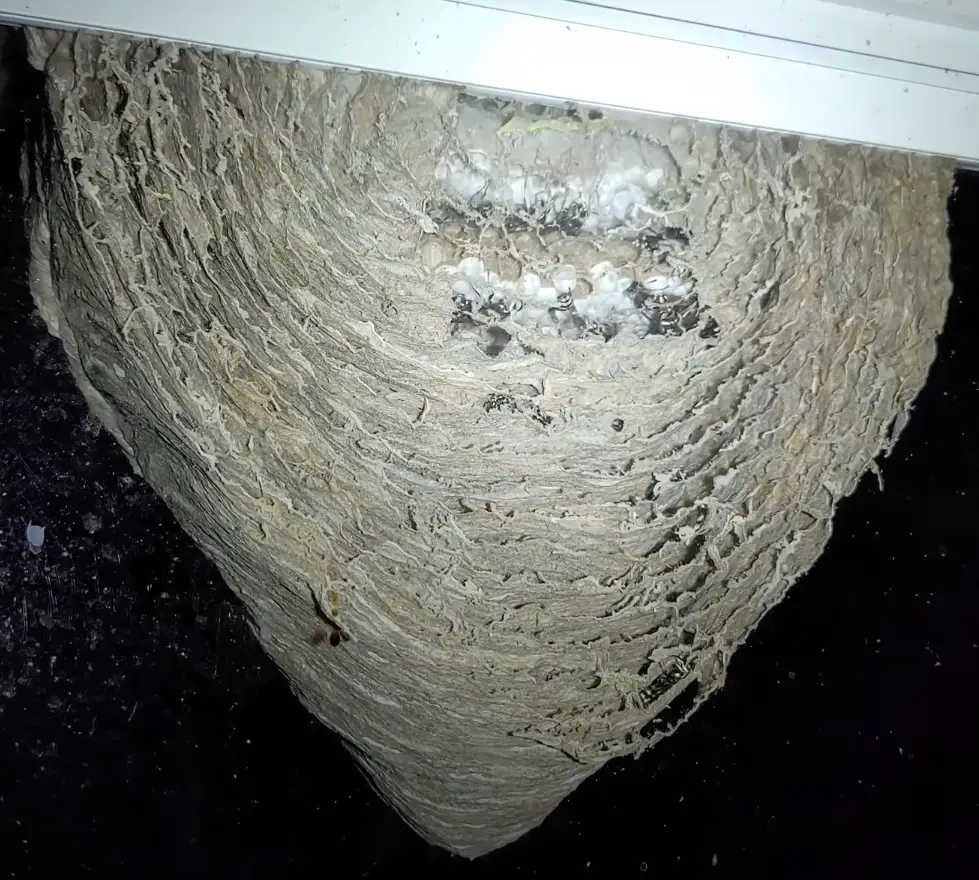
Hornets use their nests to protect the queen and her eggs as well as a place to rear their young. The nest also provides a safe place for the workers to sleep at night or during bad weather.
The cells inside the nest are used to raise the larvae. Once they pupate, they turn into adult hornets that eventually emerge from the nest to mate and start new colonies of their own.
What do hornets do in their nests?
Hornets are constantly busy inside the nests. Their time inside is spent feeding larvae and making sure that the eggs and pupae are in good shape.
They also are engaged in a constant building program for much of the time, building three or four tiers of cells and the protective covering around them as the nest lengthens.
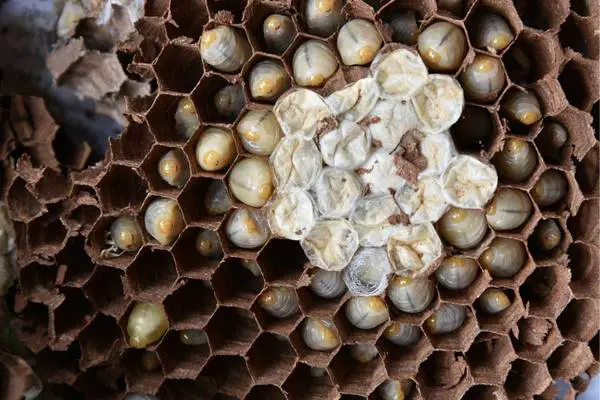
Once they taper off the bottom down to just a hole, the building program is complete, and the hornets then concentrate solely on finding food and feeding the larvae.
They also have to feed and tend to the queen, as she does nothing once she produces the first brood of workers but lounge around and lay more eggs. The workers take the eggs and place them in brood cells.
Do hornets stay in their nest at night?
Hornets usually do rest in the nest at night. However, in places in which the nights stay warm at times, they can also be active during the night.
There are some flowers that stay open during the night and some that only bloom at night, attracting moths and other night-flying insects to sample their nectar, but while hornets do occasionally eat nectar, they are primarily carnivorous and mostly eat other insects.
These insects also provide food for the hornets as well as do the flowers’ nectar. The hornets that go out at night rest just during the early morning hours before sunrise. Then it’s back to work again.
How long do hornets stay in their nest?
Hornets stay in the nest from early spring until fall. This can be as short a period as three or four months in some climates, lasting longer in places with long summers.
The males, or drones, aren’t produced until fall, then they are the first to leave to find mates.
The workers will stay until the queen stops producing eggs to care for, then they scatter to find food for themselves. The queens leave to find mates and later find a place to hibernate for the winter.
Do hornets use the same nest every year?
No, they do not reuse nests. The queens start a new nest every year. Yellow jackets, which are classified by some as wasps and by others as hornets, usually choose an abandoned hole made by an animal. They will take it over and build nest cells inside.
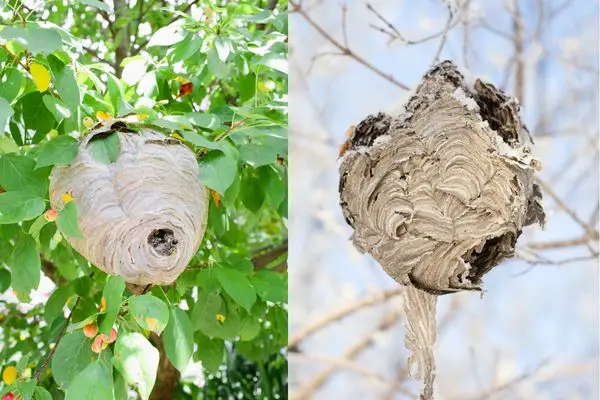
Other ground hornets, such as cicada killers, dig their own holes. They don’t use the same hole every year either.
If you want to have a large hornet nest, this means that you don’t have to worry about the insects overwintering inside or coming back to the same nest next spring.
If you want to collect a nest, it is best to wait until the early winter months as the worker hornets will die off.
Wait until the temperature gets in the 30s or so, then you can safely collect a prize nest. It’s a good idea to keep it in a warm place in a plastic bag for a few days.
Get Rid of Hornets Yourself

STEM Large Insect Spray
The Best Natural Hornet/Yellow Jacket Spray.
- Effectively kills hornets and yellow jackets
- Safe for people and pets
- Is based on natural ingredients
- Breaks down in nature
Any hornets that come out are new queens and should be released. Should any larvae or pupae be left inside, they should be very few in number and will die if they haven’t already.
Conclusion
Hornets’ nests are fascinating structures made from wood fibers that have been chewed by the hornet queen and repurposed into a porous, multilayered house for hundreds of hornet workers. The queen single-handedly builds a new nest every spring!
Hornets usually build nests on tree branches or the branches of large shrubs, at least three feet off the ground. The average hornet nest holds from 100 to 700 hornets.
Once they taper off the bottom down to just a hole, the building program is complete, and the hornets then concentrate solely on finding food and feeding the larvae.
Hornets stay in the nest from early spring until fall. Yellow jackets, which are classified by some as wasps and by others as hornets, usually choose an abandoned hole made by an animal.
They will take it over and build nest cells inside. Other ground hornets, such as cicada killers, dig their own holes. Wait until winter when the temperature gets in the 30s or so, then you can safely collect a prize nest.




